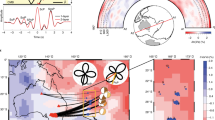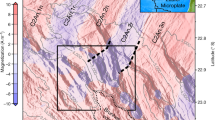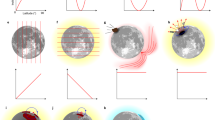Abstract
Prolonged periods of stable polarity in the Earth’s magnetic field are termed superchrons. The most recent of these intervals, the Cretaceous Normal Superchron, lasted from approximately 121 to 83 million years ago1,2 and is most commonly observed in the lack of a prominent stripe pattern3 in the sea-surface magnetic anomaly above the oceanic crust formed during this period. The exact behaviour of the geomagnetic field during this interval, however, remains unclear, as palaeomagnetic data from igneous4,5,6 and sedimentary7,8 sections yield conflicting results. Here we report a deep-tow magnetic profile from the Central Atlantic Ocean, African flank, spanning the entire Cretaceous Normal Superchron. We suggest that this profile, along with widely distributed sea-surface magnetic anomaly data, records the rising variability of the dipolar geomagnetic field at the beginning of the interval, which culminates in a highly fluctuating field between 110 and 100 million years ago. We interpret the subdued magnetic signal in the last 9 million years of the superchron as the return to a more stable geomagnetic field. This variability allows us to define two internal time markers valuable for plate reconstructions. Based on the degree of variability observed, we conclude that geodynamo models that call for low field variability may provide an oversimplified view of superchrons.
This is a preview of subscription content, access via your institution
Access options
Subscribe to this journal
Receive 12 print issues and online access
$259.00 per year
only $21.58 per issue
Buy this article
- Purchase on Springer Link
- Instant access to full article PDF
Prices may be subject to local taxes which are calculated during checkout



Similar content being viewed by others
References
Cande, S. C. & Kent, D. V. Revised calibration of the geomagnetic polarity timescale for the Late Cretaceous and Cenozoic. J. Geophys. Res. 100, 6093–6095 (1995).
He, H. Y., Pan, Y. X., Tauxe, L., Qin, H. F. & Zhu, R. X. Toward age determination of the M0r (Barremian-Aptian boundary) of the Early Cretaceous. Phys. Earth Planet. Int. 169, 41–48 (2008).
Helsley, C. E. & Steiner, M. B. Evidence for long intervals of normal polarity during Cretaceous period. Earth Planet. Sci. Lett. 5, 325–332 (1969).
Biggin, A. J., van Hinsbergen, D. J. J., Langereis, C. G., Straathof, G. B. & Deenen, M. H. L. Geomagnetic secular variation in the Cretaceous Normal Superchron and in the Jurassic. Phys. Earth Planet. Int. 169, 3–19 (2008).
Granot, R., Tauxe, L., Gee, J. S. & Ron, H. A view into the Cretaceous geomagnetic field from analysis of gabbros and submarine glasses. Earth Planet. Sci. Lett. 256, 1–11 (2007).
Tarduno, J. A., Cottrell, R. D. & Smirnov, A. V. High geomagnetic intensity during the Mid-Cretaceous from Thellier analyses of single plagioclase crystals. Science 291, 1779–1783 (2001).
Cronin, M., Tauxe, L., Constable, C., Selkin, P. & Pick, T. Noise in the quiet zone. Earth Planet. Sci. Lett. 190, 13–30 (2001).
Tarduno, J. A. Brief reversed polarity interval during the Cretaceous normal polarity superchron. Geology 18, 683–686 (1990).
Olson, P. L., Coe, R. S., Driscoll, P. E., Glatzmaier, G. A. & Roberts, P. H. Geodynamo reversal frequency and heterogeneous core-mantle boundary heat flow. Phys. Earth Planet. Int. 180, 66–79 (2010).
Linder, J. & Gilder, S. A. Geomagnetic secular variation recorded by sediments deposited during the Cretaceous Normal Superchron at low latitude. Phys. Earth Planet. Int. 187, 245–260 (2011).
Bouligand, C., Dyment, J., Gallet, Y. & Hulot, G. Geomagnetic field variations between chrons 33r and 19r (83–41 Ma) from sea-surface magnetic anomaly profiles. Earth Planet. Sci. Lett. 250, 541–560 (2006).
Cande, S. C. & Kent, D. V. Ultrahigh resolution marine magnetic anomaly profiles: A record of continuous paleointensity variations? J. Geophys. Res. 97, 15075–15083 (1992).
Gee, J. S., Cande, S. C., Hildebrand, J. A., Donnelly, K. & Parker, R. L. Geomagnetic intensity variations over the past 780 kyr obtained from near-seafloor magnetic anomalies. Nature 408, 827–832 (2000).
Pouliquen, G., Gallet, Y., Patriat, P., Dyment, J. & Tamura, C. A geomagnetic record over the last 3.5 million years from deep-tow magnetic anomaly profiles across the Central Indian Ridge. J. Geophys. Res. 106, 10941–10960 (2001).
Honsho, C. et al. Magnetic structure of a slow spreading ridge segment: Insights from near-bottom magnetic measurements on board a submersible. J. Geophys. Res. 114, B05101 (2009).
Bird, D. E., Hall, S. A., Burke, K., Casey, J. F. & Sawyer, D. S. Early Central Atlantic Ocean seafloor spreading history. Geosphere 3, 282–298 (2007).
Tucholke, B. E. & Schouten, H. Kane fracture zone. Mar. Geophys. Res. 10, 1–39 (1988).
Gee, J. S. & Kent, D. V. in Treatise on Geophysics Vol. 5, Geomagnetism (ed. Kono, M.) 455–507 (Elsevier, 2007).
Bowers, N. E., Cande, S. C., Gee, J. S., Hildebrand, J. A. & Parker, R. L. Fluctuations of the paleomagnetic field during chron C5 as recorded in near-bottom marine magnetic anomaly data. J. Geophys. Res. 106, 26379–26396 (2001).
Granot, R., Cande, S. C. & Gee, J. S. The implications of long-lived asymmetry of remanent magnetization across the North Pacific fracture zones. Earth Planet. Sci. Lett. 288, 551–563 (2009).
Tauxe, L. & Yamazaki, T. in Treatise on Geophysics Vol. 5, Geomagnetism (ed. Kono, M.) 509–563 (Elsevier, 2007).
Driscoll, P. & Olson, P. Superchron cycles driven by variable core heat flow. Geophys. Res. Lett. 38, L09304 (2011).
Haq, B. U., Hardenbol, J. & Vail, P. R. Chronology of fluctuating sea levels since the Triassic. Science 238, 1156–1167 (1987).
Seton, M., Gaina, C., Müller, R. D. & Heine, C. Mid-Cretaceous seafloor spreading pulse: Fact or fiction? Geology 37, 687–690 (2009).
Cogné, J-P., Humler, E. & Courtillot, V. Mean age of oceanic lithosphere drives eustatic sea-level change since Pangea breakup. Earth Planet. Sci. Lett. 245, 115–122 (2006).
Müller, R. D., Sdrolias, M., Gaina, C. & Roest, W. R. Age, spreading rates, and spreading asymmetry of the world’s ocean crust. Geochem. Geophys. Geosyst. 9, Q04006 (2008).
Finlay, C. C. et al. International geomagnetic reference field: The eleventh generation. Geophys. J. Int. 183, 1216–1230 (2010).
Hussenoeder, S. A., Tivey, M. A. & Schouten, H. Direct inversion of potential fields from an uneven track with application to the Mid-Atlantic Ridge. Geophys. Res. Lett. 22, 3131–3134 (1995).
Besse, J. & Courtillot, V. Apparent and true polar wander and the geometry of the geomagnetic field over the last 200 Myr. J. Geophys. Res. 107, 2300 (2002).
Biggin, A. J., McCormack, A. & Roberts, A. Paleointensity database updated and upgraded. EOS Trans. AGU 91, 15 (2010).
Acknowledgements
We thank the captains and crews of RV Le Suroît and the scientific parties for their dedication at sea on cruises Magofond 3 (2005) and Magofond 3b (2008). IPGP, CNRS-INSU, IFREMER and GENAVIR are gratefully acknowledged for their financial and technical support at various stages of the project. R.G. was supported by fellowships given by IPGP and the city of Paris. This is IPGP contribution 3255.
Author information
Authors and Affiliations
Contributions
J.D. and Y.G. designed and led data acquisition experiments. R.G. processed the data, interpreted them, and wrote the paper with contributions from both co-authors.
Corresponding author
Ethics declarations
Competing interests
The authors declare no competing financial interests.
Supplementary information
Supplementary Information
Supplementary Information (PDF 6383 kb)
Rights and permissions
About this article
Cite this article
Granot, R., Dyment, J. & Gallet, Y. Geomagnetic field variability during the Cretaceous Normal Superchron. Nature Geosci 5, 220–223 (2012). https://doi.org/10.1038/ngeo1404
Received:
Accepted:
Published:
Issue Date:
DOI: https://doi.org/10.1038/ngeo1404
This article is cited by
-
Plate tectonic chain reaction revealed by noise in the Cretaceous quiet zone
Nature Geoscience (2022)
-
The early drift of the Indian plate
Scientific Reports (2021)
-
Recent progress in identification of the geomagnetic signature of 3D outer core flows
Acta Geodaetica et Geophysica (2020)
-
GEOMAGIA50.v3: 2. A new paleomagnetic database for lake and marine sediments
Earth, Planets and Space (2015)
-
Possible links between long-term geomagnetic variations and whole-mantle convection processes
Nature Geoscience (2012)



